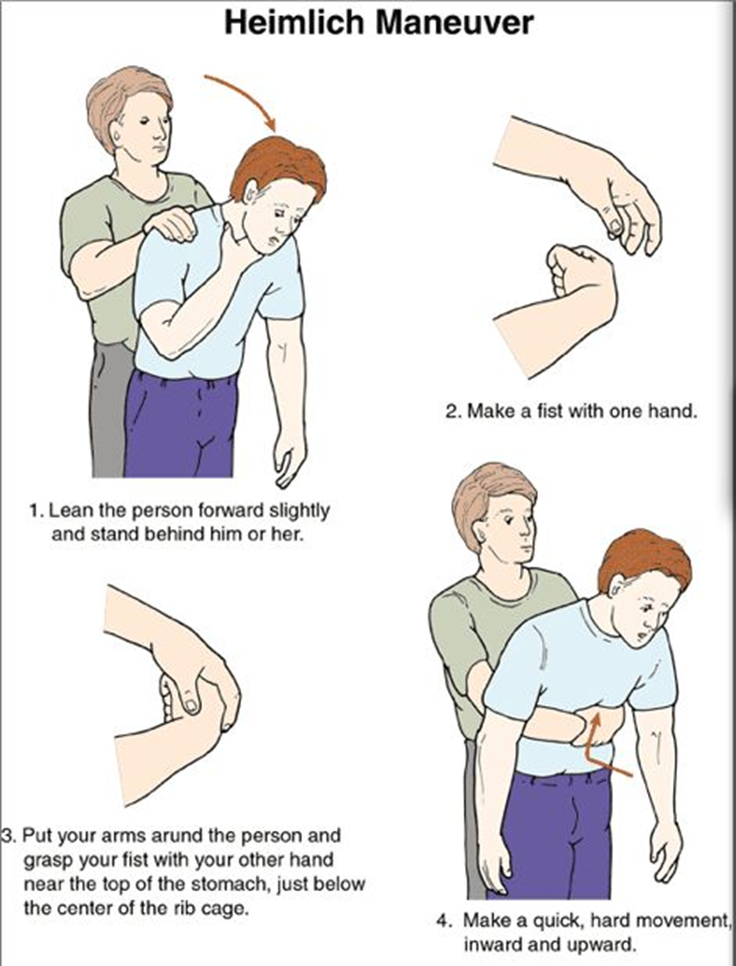A nurse is attending a social event when another guest coughs weakly once, grasps his throat with his hands, and cannot talk. Which of the following actions should the nurse take?
Perform the Heimlich maneuver.
Slap the client on the back several times.
Assist the client to the floor and begin mouth-to-mouth resuscitation.
Observe the client before taking further action.
The Correct Answer is A
Choice A reason:
The Heimlich maneuver, also known as abdominal thrusts, is the recommended first aid technique for a conscious person who is choking. This maneuver helps to expel the object blocking the airway by using the air remaining in the lungs to force it out. The nurse should stand behind the person, place their arms around the person’s waist, make a fist with one hand, and place it just above the navel. The other hand should grasp the fist, and quick, upward thrusts should be performed until the object is expelled.

Choice B reason:
Slapping the client on the back several times is not the recommended first action for a conscious adult who is choking. While back blows can be effective, they are typically used in combination with abdominal thrusts and are more commonly recommended for infants. For adults, the Heimlich maneuver is preferred as the initial response.
Choice C reason:
Assisting the client to the floor and beginning mouth-to-mouth resuscitation is not appropriate for a conscious person who is choking. Mouth-to-mouth resuscitation, or rescue breathing, is used when a person is not breathing and is unresponsive. In this scenario, the client is conscious but unable to speak, indicating a blocked airway that requires the Heimlich maneuver.
Choice D reason:
Observing the client before taking further action is not advisable in a choking emergency. Immediate intervention is crucial to prevent the situation from worsening. If the person is unable to speak, cough, or breathe, the Heimlich maneuver should be performed without delay.
Nursing Test Bank
Naxlex Comprehensive Predictor Exams
Related Questions
Correct Answer is A
Explanation
Choice A reason:
Metoprolol is a beta-blocker commonly used to treat high blood pressure (hypertension). One of its primary therapeutic effects is the reduction of blood pressure. By blocking beta-adrenergic receptors, metoprolol decreases the heart rate and the force of contraction, leading to lower blood pressure.
Choice B reason:
While metoprolol can help manage certain types of dysrhythmias by slowing the heart rate and stabilizing the heart’s rhythm, the primary therapeutic effect for which it is most commonly prescribed is the reduction of blood pressure.
Choice C reason:
Increased urine output is not a direct therapeutic effect of metoprolol. This effect is more commonly associated with diuretics, which are often used in conjunction with beta-blockers to manage hypertension and heart failure.
Choice D reason:
Decreased pulse is a potential effect of metoprolol, as it slows the heart rate. However, this is not the primary therapeutic goal. The main therapeutic effect is the reduction of blood pressure.
Correct Answer is B
Explanation
Choice A reason:
Inserting a nasogastric tube is not the first-line intervention for postoperative nausea and vomiting (PONV). This invasive procedure is typically reserved for severe cases where other interventions have failed.
Choice B reason:
Administering an antiemetic is the appropriate action. Antiemetics help control nausea and vomiting, which are common side effects of opioids like morphine. This intervention can provide immediate relief and improve the client’s comfort.
Choice C reason:
Auscultating bowel sounds is important for assessing gastrointestinal function, but it does not directly address the immediate symptom of nausea and vomiting. This assessment can be part of the overall evaluation but is not the primary intervention.
Choice D reason:
Encouraging the client to ambulate is beneficial for overall recovery and can help reduce the risk of complications such as deep vein thrombosis. However, it does not directly address the immediate issue of nausea and vomiting.
Whether you are a student looking to ace your exams or a practicing nurse seeking to enhance your expertise , our nursing education contents will empower you with the confidence and competence to make a difference in the lives of patients and become a respected leader in the healthcare field.
Visit Naxlex, invest in your future and unlock endless possibilities with our unparalleled nursing education contents today
Report Wrong Answer on the Current Question
Do you disagree with the answer? If yes, what is your expected answer? Explain.
Kindly be descriptive with the issue you are facing.
